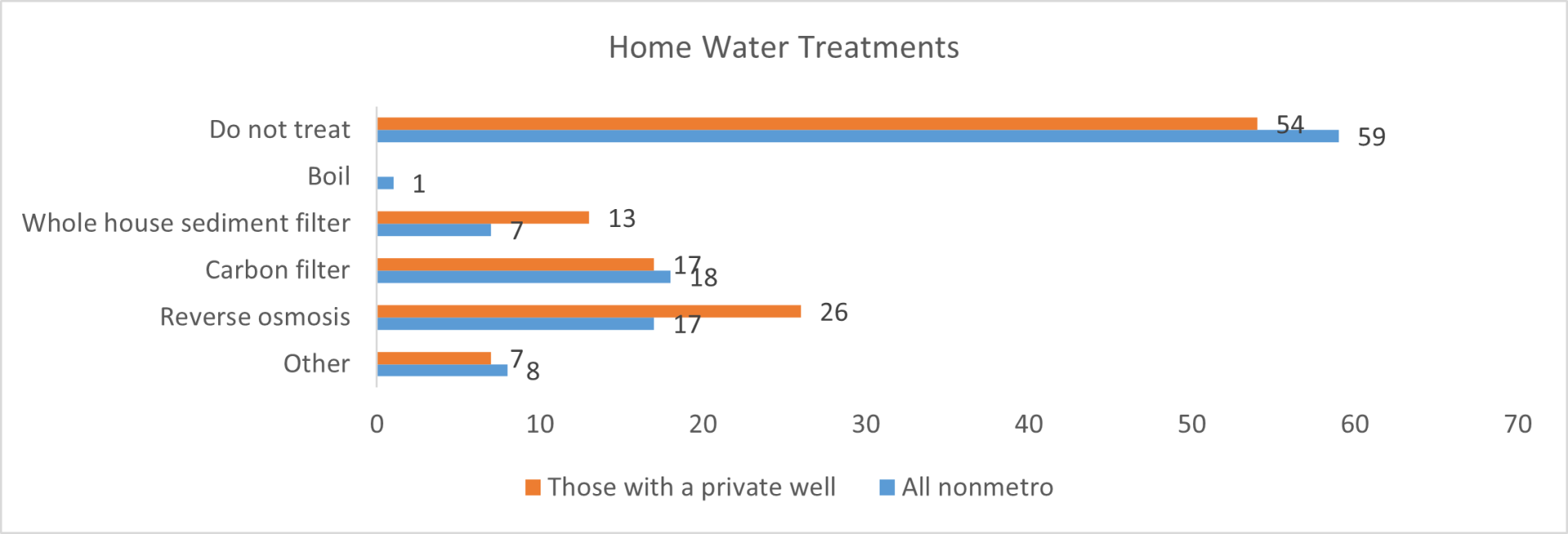Cornhusker Economics Jan. 11, 2022
Home Tap Water In Nonmetropolitan Nebraska
Water is an important resource in Nebraska. Most of the drinking water in the state (85%) comes from groundwater sources. Public water sources are required to test their water to ensure it is safe. However, private wells are not subject to any safety or quality standards. Given that, what are the main sources of home tap water for rural Nebraskans? Do they test or treat their water? The 2022 Nebraska Rural Poll examined these questions.
Most rural Nebraskans (68%) said they receive their home tap water from city water or municipal water systems. One-quarter (25%) have private well water and seven percent are on a rural water system. The use of private well water is more prevalent in and around smaller communities. Just under four in ten (38%) persons living in or near the smallest communities (populations less than 500) have private well water, compared to less than two in ten persons living in or near the largest communities (populations of 10,000 or more). Differences in sources of their home tap water also occurred by region. Persons living in both the North Central and Panhandle regions are more likely than persons living in other regions of the state to have private well water. Approximately one-third of persons living in these two regions have a private well as the primary source of their home tap water, compared to less than two in ten persons (19%) living in the Southeast region of the state.
Home Water Testing
Respondents were next asked if their home tap water has been tested for various substances. No time frame was given, so there is no way to determine if recent tests have been conducted. Many rural Nebraskans (31%) have tested their home tap water for nitrates. Just over three in ten have tested their water for nitrates. However, a similar proportion indicated they have not tested their water or are unsure. Just under one-quarter have tested their water for E. coli, lead and hardness.
Given that most rural Nebraskans receive their drinking water from municipal water systems (who are required to test their water), it is important to look at the subset that receives their drinking water from a private well. Most rural Nebraskans with private well water (55%) have tested their water for nitrates while almost four in ten have tested for E. coli, lead, and pesticides. Just under one-quarter (23%) of rural Nebraskans who get their drinking water from private wells have not tested their water and 11.5% are unsure if it has been tested.

There were also differences in testing by household income. Rural Nebraskans with higher household incomes are more likely to have tested their home tap water for contaminants than those with lower incomes. Almost four in 10 rural Nebraskans with household incomes of $100,000 or higher have tested their water for nitrates, compared to just over two in 10 persons with household incomes under $40,000. And those with the lowest household incomes are more likely to be unsure – 44% – if their water has been tested.
Home Water Treatments
If home water testing does reveal the presence of contaminants beyond recommended levels, various treatment options are available. Respondents were asked if they treat their home tap water for safety before drinking it. Most rural Nebraskans (59%) do not treat their home tap water before drinking it. Just under two in ten treat their home tap water using either a carbon filter or reverse osmosis.
When the data for just those who get their drinking water from a private well are examined, most (54%) are not treating their tap water before drinking. However, private well owners are more likely to use both whole house sediment filters (13%) and reverse osmosis systems (26%) than all nonmetropolitan residents.
A difference by household income was again found when examining the use of these treatment methods. Persons with higher household incomes are more likely than persons with lower incomes to use whole house sediment filters, carbon filters and reverse osmosis to treat their home tap water.

Summary
In summary, these findings indicate that many rural Nebraskans are testing their water. In fact, many who rely on private well sources for their drinking water are testing – particularly for nitrates. However, there is certainly room for improvement. One potential barrier to both testing is cost. In fact, the finding that higher income households are more likely than lower income households to test their water supports this hypothesis. However, there are many free programs available for testing. For more information on water testing, check out this publication from Nebraska Extension. An overview of water treatment methods is included in this publication.
Rebecca Vogt
Department of Agricultural Economics
University of Nebraska-Lincoln
402-750-1727
rvogt2@unl.edu